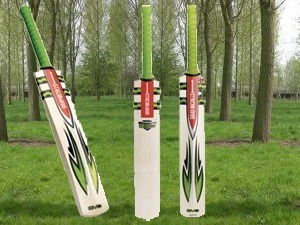
Today the fourth cricket test match in the famous Ashes series begins in Melbourne Australia. Without three different species of trees and the unique properties of their woods, the sport would not exist.
The cricket bat
Cricket bats are made from the cricket-bat willow Salix alba var. caerulea. The trees are grown mostly in England. They are ‘planted’ as sets – a carefully selected cutting (i.e. without roots) from quality stock is pushed into the ground in a hole prepared with a metal bar. The best growing sites are water meadows near to streams and rivers, often overlying clay and with a high water table. Growers have to tend the trees carefully if they are to sell to cricket bat makers; one of the most important things being the removal of small epicormic shoots on the stem. If allowed to grow these form small pin-sized knots in the wood which weaken it and hence reduce its value.
The trees are normally felled between 15 and 20 years after planting. They are typically purchased by a specialist buyer such as J S Wright & Sons Ltd. Unusually for timber sales, price is less dependent on volume than quality, with each tree being worth typically £200-300. Back at their yards the buyers cross-cut the stems to 71cm (28″) lengths and them create the basic shape of the blade called the ‘cleft’. These are then graded before being carefully stacked for air-drying in readiness for selling to bat makers one year later.
The cricket bat makers carefully select each piece looking to exploit the natural spring in willow. The clefts are shaped and then pressed carefully; just enough to retain some of the natural air pockets in the timber to create a lively and responsive bat. Finally, the shoulders are shaped and a handle fitted of rattan cane (actually a forest vine) from Malaysia.
The stumps and bails
The wicket is usually made from ash Fraxinus excelsior. The superior flexibility of ash wood is exploited in many sporting and utility goods including tennis racquets, hockey sticks, and handles for axes and sledgehammers. For cricket stumps and bails the very best straight and clean wood is selected. For the modern game, in addition to being turned to create the shapes and points, they are often prepared for TV coverage by being hollowed out to contain the tiny wicket cam and branded with logos.
The ball
The cricket ball may have a less obvious connection with trees. Every fan talks about the “thwack of leather on willow” but at the heart of a quality cricket ball is cork from the cork oak Quercus suber. The cork oak grows in southern Europe including Spain, Portugal and Italy, and in North Africa: from 25 years old the trees can be harvested sustainably every 12-15 years for their lives, which may be 150 years or more. To make a ball, layers of cork are tightly wound with string before being clad in leather.
Gabriel Hemery
 This work is licensed under a Creative Commons Attribution- NonCommercial- NoDerivs 3.0 United States License.
This work is licensed under a Creative Commons Attribution- NonCommercial- NoDerivs 3.0 United States License.

We have a 9 foot ash stump to be removed, could it be used for something? I can’t get my arms around it.
Very informative article and one with great traditions. What often escapes some people is just how much of the natural world goes into each of our national sports. As for the Ashes? Well so far we’re in control and may well retain the Ashes. Winning on Aussie territory is always a bonus too.
If anyone wants to see a cork oak in this country (saves on the travelling to the Mediterranean) there is a reasonably fine specimen in the grounds of Arundel Castle. Just ask the staff on site and they will point you in the right direction.
Thanks Kev – a very interesting comment too! I didn’t know there was a cork oak at Arundel Castle -perhaps the most Northly in Europe? I wonder too whether its cork has ever been harvested?
Gabriel